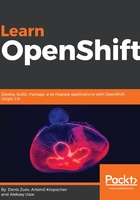
Creating kubernetes services using YAML and JSON files
You can also create Kubernetes resources manually using YAML and JSON files. Let's go ahead and create a simple pod running a httpd web server using the kubectl create command. We will have to create a YAML-formatted file:
$ cat httpd-pod.yaml
apiVersion: v1
kind: Pod
metadata:
name: httpd
namespace: default
spec:
containers:
- name: httpd-container
image: httpd
ports:
- containerPort: 80
It may look a bit complicated and hard to understand, but as we move on in this book, you will see a lot of similarities between these YAML and JSON files.
Create a pod using the httpd-pod.yaml file:
$ kubectl create -f httpd-pod.yaml
$ kubectl get all
NAME READY STATUS RESTARTS AGE
po/httpd 1/1 Running 0 25s
NAME TYPE CLUSTER-IP EXTERNAL-IP PORT(S) AGE
svc/kubernetes ClusterIP 10.96.0.1 <none> 443/TCP 56s
This command creates a pod named httpd; it does not create anything else. In larger deployments with heavy automation involved, this is the way to deploy Kubernetes resources, but this, of course, requires better Kubernetes skills.
Similarly, we can create other Kubernetes resources, including ReplicaSet, Deployment, and others.